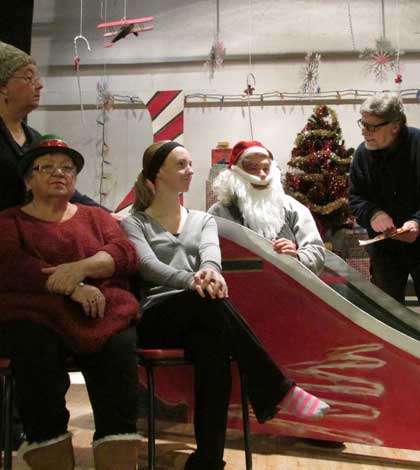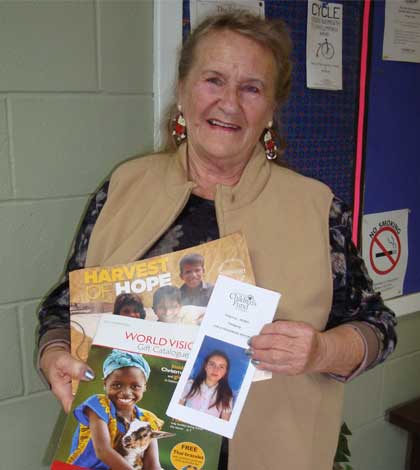LITTLE CURRENT—The Soaring Through the Years Elders Symposium held in the new Manitoulin Hotel and Conference Centre contained an action packed agenda aimed at arming First Nation elders with the knowledge and tools they may need to understand the life challenges faced by seniors.
Entering the main hall of the hotel, elders and visitors were greeted with a bright and cheerful smile by organizer Debbie Selent, home care nurse manager at Mnaamodzawin, as she and her assistants handed out symposium packages and directed attendees to their seats in the hall.
Following a light morning breakfast, the main hall of the conference centre was filled to capacity with the elderly and their caregivers, while around the outside walls a number of booths with representatives and literature from local health providers and agencies stood ready to answer questions and provide brochures, pamphlets and small gifts to attendees.
Master of Ceremonies Chris Pheasant kept the agenda moving with his patented patois; a mix of lighthearted humour and pithy observations. A welcome song was delivered by the Nimkii N’Gunsai drum group and Justine Mitchell delivered the opening prayer. A long procession of young dancers in colourful regalia processed twice around the assembled gathering as part of the opening ceremonies.
Chief Irene Kells of Zhiibaahaasing First Nation delivered the opening remarks, welcoming the attendees and presenters and sharing some of her own history as a foster child and invoking memories of the first elders’ gatherings she recalled. “Mary Lou Fox used to have these elders’ gatherings,” she said. “It is at those gatherings that I first began to learn about the culture.”
Chief Kells noted that a key part of the value in the elders’ symposium lies in providing elders with an opportunity to get out and mingle. “It is hard for some elders to get out and about,” she said. “This is the perfect place to go out, mingle and enjoy yourself. It is a blessing.”
The meat of the one-day symposium began with a presentation by Dr. James Chau from the Elliot Lake Family Health Team entitled ‘Dancing with the Three Ds: An approach to dementia, delirium and depression.’
“You are probably looking at me and wondering ‘what do I know about dancing?’,” joked the doctor as he opened his serious subject matter with a little lighthearted banter. “That’s fine, I know nothing about dancing.”
Dr. Chau said that he was not going to be speaking on the most famous of the Ds, diabetes, but that his talk was going to focus on dementia, delirium and depression.
The key difference between the natural cognitive issues that manifest themselves in misplaced car keys and the growing need for grocery lists or other relatively benign memory challenges as people age is when memory issues begin to impact a person’s ability to function. “It is when memory problems start effecting function that we begin to have concerns,” he said. “The type (of dementia) we hear the most about is Alzheimer’s.” But there are actually a number of dementia conditions that exhibit a gradual and progressive set of symptoms impacting mental processing and abstract thinking including short term memory, communication and language and judgment and reasoning. The main types of dementia are the aforementioned Alzheimer’s disease, lewy body (a Parkinson’s-like condition caused by buildup of proteins in the brain), vascular and frontotemporal.
Delirium, on the other hand, is characterized by an acute onset of confusion impacting attention, consciousness and disorganized thinking which can fluctuate in intensity and exhibition. It is very important to note that delirium is indicative of a medical emergency.
“This is a very important condition to be aware of,” said Dr. Ingram. “Onset can occur in a very short period of time.” The condition can also fluctuate rapidly, changing from hour to hour. “A person can be bright and upbeat one moment and the very next be tired and confused.”
The reason awareness of delirium is so critical is that it can be life-threatening. “There is a 10 percent increased chance of dying for patients with delirium in hospital,” said Dr. Ingram.
There are three basic categories of delirium, hyperactive (approximately 25 to 30 percent of cases), hypoactive (approximately 25 to 50 percent) and mixed.
In hyperactive delirium, the individual is confused but very active. “They seem to be on the go all the time, there may be hallucinations and they require a lot of assistance from medical staff,” said Dr. Ingram.
On the other hand, it is very easy to miss hypoactive delirium, as it is characterized by low energy and sufferers tend to sleep a lot of the time. “They tend to be overlooked,” he said. Common perceptions evinced by the statements “the old get confused” and the assumption that “it’s dementia” can mask awareness of the onset of delirium. “We tend to just blame it on dementia, but it is a medical emergency, so we don’t want to over look it,” said Dr. Ingram.
There are also those who can swing between the two states.
Predisposition to delirium can be found in factors such as being over 75, having other medical illnesses, trauma, memory troubles, depression, previous delirium episodes, nutritional deficiencies and commonly, social losses such as the death of a spouse or close friend. “Trauma can act as a trigger,” said Dr. Ingram.
Surprisingly, along with conditions such as dehydration, blood sugar imbalances and medications or injuries, poor fitting hearing aids or glasses can trigger delirium. People are more likely to experience delirium if they have had it before, have memory or thinking problems, have a severe illness resulting in hospital stays, are dehydrated, have problems seeing or hearing or are taking more than five medications
Clinical depression, unlike a case of being down in the dumps, is defined as being in place “most of the time over two weeks” and is generally “out of the ordinary” for the individual. Clinicians use the general features encapsulated in the mnemonic “sig-e-caps,” sleep, interest, guilt, energy, concentration, appetite, psychomotor changes and suicidal thoughts. Depression is often manifested in increased anxiety and irritability in an individual, beyond that exhibited in their own normal personality.
Depression can be brought on by life losses, chronic illness and pain, dementia, stroke, Parkinson’s, living in a nursing home, hospital or drug reactions.
The indicators for the three D’s can overlap and intermingle, so it is vital that health professionals “get the whole story” when diagnosing and treating the symptoms.
Basically, one of the key differences lies in the onset of the condition. Delirium comes on quickly, fluctuates from hours to weeks and is reversible. Dementia is gradual, a slow decline over months to years and is irreversible. Depression is subacute, recurrent and chronic covering a period of weeks to months and is also usually reversible.
Mood is another key indicator. With delirium there are fluctuations in mood, whereas dementia is stage dependent and is often characterized by apathy while depression also exhibits with a loss of interest in pursuits that an individual used to take pleasure in.
The intermingling of symptoms and the fact that an individual could be suffering from more than one of the three D’s at once means getting the whole story is very important. That includes timelines, a person’s speech, mood, thinking and the application of cognitive and physical testing.
One of the questions asked of Dr. Ingram following his presentation was how to deal with the delays in seeing specialists once diagnosed with one of the three D’s. Dr. Ingram answered that many medical professionals, such as family doctors and nurse practitioners, are far more aware of the conditions and strategies to deal with them and can likely assist with interim stratagems.
Other presentations at the symposium included a presentation by Dr. Restoule on ‘Feeling Good: The Mind Body Connection and Derek Debassige of the Manitoulin Physio Centre on ‘Falls Prevention.’
Entertainment during the symposium included a visit by ‘Elvis.’ Because when it comes to having fun while learning, noted Mr. Pheasant, “everybody loves Elvis!”





